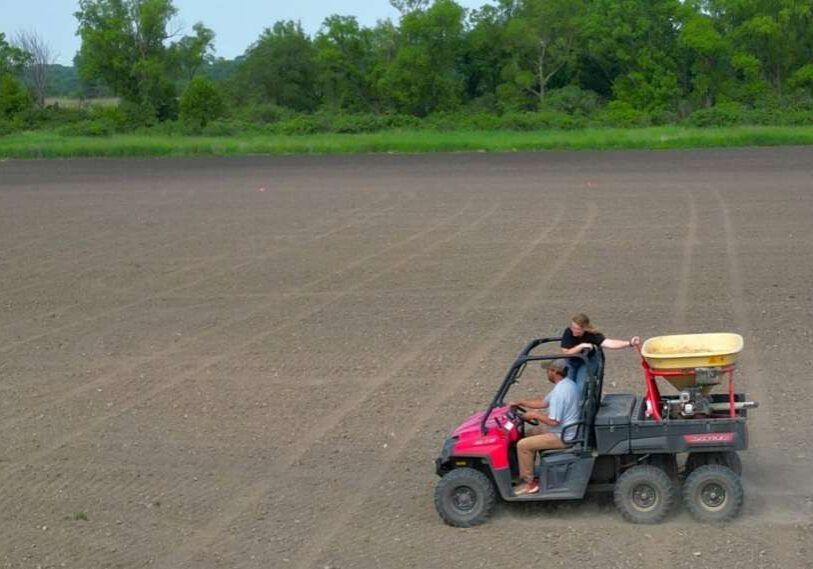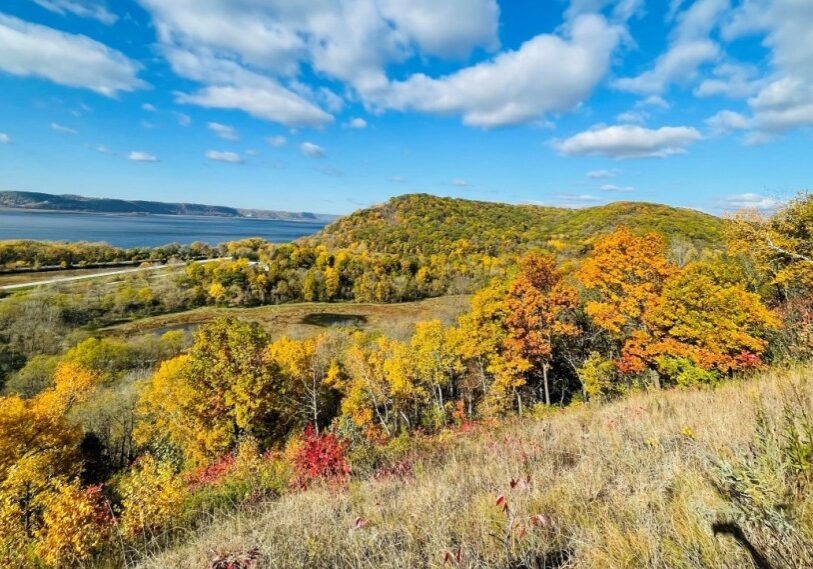Barb and Joel Mielke’s 37-Year Quest for Biodiversity in Bluff Country
From childhood connections with the land, to nurturing one of Southeast Minnesota’s largest bat colonies, this couple maintains their passion for conservation

This article is the third in a series focusing on conversations about conservation with southeastern Minnesota farmers, landowners and conservationists.
CARROLTON TOWNSHIP, FILLMORE COUNTY—In the 37 years that Joel and Barb Mielke lived northeast of Preston, Minn., they have devoted themselves wholeheartedly to their diverse landscape through many different acts of conservation.
Their work is inspired by their childhood connections to being outdoors and having the freedom to explore. Joel grew up on a farm near Hutchinson, Minn., as one of six children, and he often spent a lot of time outside by himself exploring the woods, creek and sloughs of his family’s farm. Barb grew up in the Twin Cities but would often visit family in rural Chatfield to share in farm life and the great outdoors.
Their lives came together when they met at the University of Minnesota, got married and lived and worked as engineers in the Twin Cities. While Barb and Joel noticed many Twin Cities families buying land or having a cabin in lake country up north, they decided to look for land in southeastern Minnesota instead.
They both loved the area with its unique landscape and close proximity to the Twin Cities with the bonus of less weekend traffic heading southbound than northbound. They found their current property along County Highway 17 between Preston and the Root River Trail; it includes woodlands, hills and deep ravines that go right to the Root River, and purchased it in 1988.
Biodiversity mission
When their two daughters were young, Joel would often go on the weekends to start the conservation work on their land. He learned about different practices through Nature Conservancy events, and began trying to remove invasive plant species.
As landowners, the Mielke’s mission became to foster a diverse mix of plants that are native to the area.

Cliff-brake, a fern native to Minnesota, grows in a rock crevice on Barb and Joel Mielke’s property northeast of Preston. (Photo by Alison Leathers)
Barb and Joel worked hard and continue to work on removing invasive plants such as buckthorn, honeysuckle, musk thistle, eastern red cedar, wild parsnip, garlic mustard, Japanese hop, Japanese barberry, European high bush cranberry, multi-flora rose, oriental bittersweet and Queen Anne’s lace.
In line with their mission, they maintain different landscapes throughout their acreage, which include prairie, oak savannah, woodland and a riparian mix.
One year they planted 12,000 trees, mainly oak, cherry, walnut and pines. They caged about 200 trees to protect them from deer.
Bluejays help add oaks to the landscape as they can put three acorns in their mouth and fly away, dispersing the acorns to germinate where they are dropped. The Mielkes like oak trees as they are host trees to many moths and butterflies, whose caterpillars are a food source for baby birds.
The Mielkes are on the lookout for biodiversity whenever they are out working or enjoying their property. They’ve noticed different snakes on their property, and after getting advice, they put out corrugated tin on the ground in different spots to attract mice, and then the snakes would come and they could lift up the tin to inventory the snakes, which include red-bellied, garter, fox and milk snakes.
They have identified five different katydid insects and are trying to learn more to identify the multitudes of insects that surround them.

Goldenseal (on the left) and Adoxa (on the right), are rare plants found on the Mielke property. (Photos submitted by Joel Mielke)
Two years ago, Joel identified a rare native plant called goldenseal and reported it to the Minnesota Department of Natural Resources (DNR). Botanist Derek Anderson brought two of his colleagues, including head botanists Welby Smith and Michael Lee, to confirm the goldenseal finding on the Mielke’s property.
“When they came,” Joel shared, “they could see that goldenseal was all over, and they were amazed.” The DNR botanists looked for other species and found another rare plant called Adoxa. (Photos of the blooming goldenseal on the Mielke’s land will be featured in the next issue of Searching for Minnesota’s Native Wildflowers by Kelly Povo and Phyllis Root, who were thrilled to photograph it for the first time in their careers.)
These different landscapes on the Mielke property support a diversity of plants, which in turn support a diversity of insects, a diversity of birds, a diversity of amphibians and reptiles and then ultimately support a diversity of small mammals. The Mielkes continue to marvel at what unique plant and animal species they find on their land.
Removing the buckthorn
Over the last 13 years, the Mielkes have really focused on buckthorn removal, which includes removing the large seed trees, sometimes up to 25-feet tall, all the way down to the millions of seedlings.
Their buckthorn removal methods include girdling the tall trees, foliar spraying the trees that are up to 6-feet tall and allowing their neighbor’s cattle to trample the seedlings from May through November. Before the cows could come in to help with the buckthorn, the Mielkes replaced and rebuilt the fence that encloses this 45-acre piece of their property.

Cows at a prescribed burn on the Mielke property. (Photo submitted by Joel Mielke)
When the tornados hit Fillmore County in December 2021, a lot of big trees fell on these 45 acres which prevented the cows from accessing areas to easily graze. Joel and Barb were concerned that the buckthorn would return quickly and easily. They considered renting goats to graze these tougher spaces, but they knew that would be impractical for that large of a section.
Thankfully, the buckthorn has not returned on a massive scale and as Joel states, “nature came in instead.” Red-headed woodpeckers, which are less common than other woodpeckers, are now on this land using the dead trees for cavity nesting. The Mielkes, meanwhile, continue to watch for buckthorn as robins bring back seeds from neighboring land.
Prairie time
Prairie habitat was always on the Mielkes’ minds. “Our first prairie planting was in our yard in Inver Grove Heights,” says Barb.
They have since applied their knowledge of prairies to their Fillmore County land. They cleared acres of their land and planted their first prairies, using seed purchased from Shooting Star Native Seeds. There are currently 130 acres of prairie on their property, and they utilize the USDA Farm Service Agency’s Conservation Reserve Program (CRP) by enrolling those acres as CRP, which provide cost-share assistance to the landowner.

Some of the prairie the Mielkes have planted and maintained include Indian grass, sideoats grama and little bluestem which are common native prairie grasses. (Photo by Alison Leathers)
To manage their prairie habitats, the Mielkes canvas the fields several times each summer and use herbicides to spot treat invasives like Wild Parsnip and Queen Anne’s lace. In the Spring, they use prescribed burns to remove woody invasives like boxelder trees.
As their prairies thrive, they notice more insects, like crickets, also thrive in the prairie and enjoy seeing different bird species, like meadowlarks and bobolinks and the endangered henslow’s sparrow.
To help identify birds, Barb and Joel utilize the free Merlin Bird ID App through Cornell University, which can listen to bird sounds and identify what birds are heard.
Bluebirds rebound and bats abound
When Joel grew up in Hutchinson, he never saw a bluebird. Bluebirds are cavity nesters, and people often cut down those trees that provide habitat for bluebirds.
After learning about how to help the bluebird population through the Bluebird Program of Minnesota, the Mielkes decided to start building bluebird houses in the early 1990s. Joel put up these bluebird houses around their property and Barb continues to monitor those houses. Since gathering data in 2009, they have fledged over 1500 bluebirds.
The original farmhouse on the property was not livable, so they decided to burn it down. But, they knew that a large bat colony lived in the old farmhouse, so they had to provide housing for the bats when they came back after the winter – a four-chamber bat house, about the size of a large suitcase, was mounted on their cabin’s exterior.
They sat outside at dusk and used a clicker to count the population, and they marveled at the colony’s size. Barb explained, “the bat moms and their pups usually live in the bat house, and they like it crowded and warm.” At the colony’s peak, they counted about 1025 bats that would come to the bat house.

The two bat houses that are on the Mielke’s cabin. (Photos by Joel Mielke)
Unfortunately, white-nose syndrome – a deadly bat infection – hit in 2018-2019 and the colony dropped to 35 bats. Thankfully, the Mielkes have witnessed the colony’s road to recovery as they counted 310 bats this summer.
“They only have one pup a year,” Barb noted, “so the population recovery takes time. Bats also recruit bats from other sites to come and join their colony.”
The Mielkes know the bats enjoy plentiful insect food on their property and above the Root River, so they look forward to monitoring the bat population and building new bat houses as the original houses are ready for replacement.
This year, Barb found an article asking for bat data so she responded, and a small mammal specialist from the DNR, Melissa Boman, came to the Mielke property to check out the bat colony. Boman said that the Mielkes have the third largest bat colony that they know of in southeastern Minnesota, following behind Mystery Cave and Whitewater State Park.
Boman also confirmed that they have the bat species called little browns, and she recommended adding a free standing bat house higher off the ground as it is good to give more than one housing option to bats.
More work to be done
The Mielkes have devoted the last 37 years to promoting conservation and biodiversity on their land, and they still have some projects they want to tackle.
There’s a pond on the land that has gone dry, so they are hiring a local contractor to dig it out and line it to provide habitat for frogs, ducks and other creatures. They will continue to experiment with and plant various tree species, like sycamore, chinkapin oak, bald cypress and northern pecan, that thrive further south, as they suspect climate change will allow these more southern trees to thrive in Minnesota.

Barb holding seed from the compass plant. In the fall, Barb and Joel often take walks and help spread some of the seeds from their prairie. (Photo by Alison Leathers)
Barb and Joel also have a mission to continue learning and serving. They are members of the Harmony Garden Club and The Prairie Enthusiasts, and they have worked with Fillmore County Soil and Water Conservation District (SWCD) to help with projects on their land.
The Mielke’s serve their community with their time and talents – in 2024 they hosted a SWCD forestry and prairie walk, and they continue to find ways to teach others about prescribed prairie burns.
Clearly, the conservation efforts made by Joel and Barb have allowed thousands of various species to thrive, ultimately contributing to a great biodiversity that can spread beyond their land’s borders. They are driven by a passion for the land and its creatures, great and small.
As Joel said, “We are engineers, and I process numerically. We are always trying to answer, ‘What does it mean, and how can we understand this?’ ”.
Their mission for conservation and biodiversity will continue as they share their data and observations and try to support the preservation of their diverse landscapes.
If you grow it, they will come
Barb and Joel Mielke’s thoughtfully restored native prairies attract a wide variety of pollinators, including monarch butterflies during their seasonal migrations. (Video courtesy of Mielkes)
Here are easy ways you can practice conservation and enjoy the biodiversity around you.
- Find volunteer conservation opportunities through the MN DNR, the Minnesota Master Naturalist Program, the Friends of the Mississippi River, or with your City or Township.
- Download the free Merlin Bird ID App to identify birds in your yard or during a hike at local spots Isinours State Forest Unit or Eagle Bluff Environmental Learning Center.
- Plant native flowers and grasses in your landscaping. The MN DNR has great resources on how to get started.
- Find ways to help bats on your land from the University of Minnesota Extension Service and from Melissa Boman’s article in the Minnesota Conservation Volunteer.
- Just as Joel collects precipitation data, you can too! Sign up to report daily precipitation monitoring through CoCoRaHs (Community Collaborative Rain, Hail, and Snow Network).
Read Alison Leathers’ other Conservation Conversations:
Part One: Duane Bakke’s 47-year farming career dedicated to conservation.
Part Two: Fillmore County SWCD, a vital resource for those taking on conservation practices.
Root River Current also has these stories about native and prairie plantings and management:
Two local seed companies help landowners restore native landscapes.






